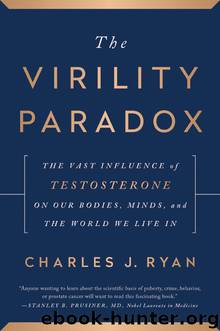The Virility Paradox by Charles J. Ryan

Author:Charles J. Ryan [Ryan Charles J.]
Language: eng
Format: epub
ISBN: 9781944648572
Publisher: BenBella Books, Inc.
SO, WHAT DOES BALDNESS REALLY SAY?
We still haven’t answered the question of why so many men go to such great lengths to combat hair loss in the first place. You might imagine that if hair loss were truly a marker of unattractiveness, it would be disappearing over the generations, as balding males would have trouble mating and the gene would have been removed from the gene pool. The fact that it still affects more than 40 percent of adult men clearly argues against this.* Even though baldness typically occurs after the age at which a man would have reproduced, that age of course has risen, and even baldness that strikes earlier remains fairly common. Baldness itself may not have anything to do with sexual selection at all. What does baldness really tell us, if anything?
Some research suggests it telegraphs health problems. It is in fact true that baldness may signal a higher risk of serious health issues, including diabetes, heart attacks, and aggressive prostate cancer.78 Such relationships first came to light in the early 1990s, when researchers at Boston University assessed the hair of 665 men under age fifty-five who were admitted with non-fatal heart attacks to a cluster of New England hospitals. They reported some degree of baldness in 34 percent of the heart-attack victims and severe baldness in another 24 percent of the subjects. As a control arm for this study, they evaluated the hair of over 770 men of the same age admitted to the same hospitals but for medical problems other than heart attack. In making these comparisons, they revealed that the relative risk of a heart attack for those men with vertex (top-of-the-head) baldness was 3.4. Translation: bald men were almost three and a half times more likely to experience heart problems.79
Interestingly, this original study was done during a time when topical minoxidil was gaining popularity as a baldness treatment, and there had been concern that the drug itself was causing heart problems. The Boston University study was in fact initiated to determine whether there was a link between minoxidil and heart attacks. It turned out, however, that baldness was the link, not the baldness treatment. (This is an important observation in light of the finasteride data; there also we must ask whether the problem is the treatment or the disease itself.) In 2013, a Taiwanese research group reported a twofold increase in the risk of death from diabetes in men and women with androgenic alopecia, and in fact the severity of hair loss correlated with the risk of death. Moreover, in a multivariate analysis, baldness emerged as an independent risk factor for the disease.80
There is actually a silver lining here. Although men may not be ready to embrace baldness, perhaps they can at least use baldness to their advantage: it may alert some individuals to their risks of heart disease, diabetes, and prostate cancer. Baldness is not a disease or even a medical problem per se, yet it seems to be an early warning sign that other problems may loom in the future.
Download
This site does not store any files on its server. We only index and link to content provided by other sites. Please contact the content providers to delete copyright contents if any and email us, we'll remove relevant links or contents immediately.
Alchemy and Alchemists by C. J. S. Thompson(3294)
The Elements by Theodore Gray(2852)
The Club by A.L. Brooks(2747)
How to Make Your Own Soap by Sally Hornsey(2741)
Drugs Unlimited by Mike Power(2484)
Wheels of Life by Anodea Judith(1917)
Cracking the Sat French Subject Test, 2013-2014 Edition by The Princeton Review(1766)
Perfume by Jean-Claude Ellena(1735)
The Flavor Matrix by James Briscione(1713)
The Cosmic Machine: The Science That Runs Our Universe and the Story Behind It by Scott Bembenek(1693)
Cracking the LSAT, 2012 Edition by Princeton Review(1688)
MCAT Physics and Math Review by Princeton Review(1567)
1000 Multiple-Choice Questions in Organic Chemistry by Organic Chemistry Academy(1566)
Cracking the SAT Premium Edition with 6 Practice Tests, 2017 by Princeton Review(1480)
The Thing Around Your Neck by Chimamanda Ngozi Adichie(1479)
Handbook of Modern Sensors by Jacob Fraden(1477)
A is for Arsenic: The Poisons of Agatha Christie (Bloomsbury Sigma) by Kathryn Harkup(1455)
Synchrotron Light Sources and Free-Electron Lasers by Eberhard J. Jaeschke Shaukat Khan Jochen R. Schneider & Jerome B. Hastings(1454)
Harry Potter All Books: 8 Books by J.k.rowling(1436)
